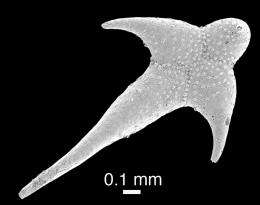Fossil record receives new timeline

Beginning around 542 million years ago, a profusion of animals with shells and skeletons began to appear in the fossil record. So many life forms appeared during this time that it is often referred to as the "Cambrian Explosion."
Geologists at UC Santa Barbara and a team of co-authors have proposed a rethinking of the timeline of these early animal appearances. Their findings are published in the latest issue of the Geological Society of America Bulletin.
Charles Darwin, in his book "On the Origin of Species," was troubled by the way the fossil record of this great proliferation of animals seemed to undermine his theory of evolution, and speculated that the pattern was due to the incompleteness of the geologic record.
"We found that with improved dating and correlation of rock sequences, the short burst of appearances goes away." said Susannah Porter, associate professor in the Department of Earth Science at UC Santa Barbara. "Instead, appearances of the earliest skeleton-forming animals were drawn out over more than 20 million years."
UC Santa Barbara graduate student John Moore added that skeletal animals became diverse much earlier than was thought, with nearly half of the animal genera in the dataset appearing in the first 10 million years of the Cambrian Period.
"The Cambrian diversification of animals was long thought to have begun with an explosive phase at the start of the Tommotian Stage, 17 million years above the base of the Cambrian," said Adam Maloof, first author and assistant professor of geosciences at Princeton University. "To test this idea, we matched earliest Cambrian records of carbon isotope variability from Siberia, Mongolia, and China with a Moroccan record constrained by five radiometric ages from interbedded volcanic ashes." This time interval was from 542 million to 520 million years ago.
This approach avoids the circularity associated with using fossils to correlate rocks, and then using those correlations to infer biological patterns, explained Porter.
Porter said that, in addition to improving the timeline of early animal evolution, the team generated proxy records for sea level, carbon cycling, and the chemistry of oxidation-reduction in the ocean — from the same sediments that contain the early animal fossils. The results indicate that early skeletal animals appeared during a 20-million-year interval of rising sea levels and increasingly oxidizing conditions at the sediment-water interface in shallow water environments.
Provided by University of California




















